Going waterwise at Rollingwood City Hall
Putting their money where their mouth is, more and more cities that urge citizens to reduce their water usage are replacing thirsty lawns around courthouses and city halls with xeric landscaping. Rollingwood, a tiny city of around 500 homes just three miles from downtown and surrounded by greater Austin, is setting a fine example with its new City Hall Waterwise Garden at 403 Nixon Drive, installed in autumn 2013.
Not every city has the wherewithal to get the famous Ogdens — part-time Austin residents Scott Ogden and Lauren Springer Ogden of Plant-Driven Design — to design it, however. Hired by the city, which received $16,000 in donations from residents (about half of the total design and installation cost, according to the Statesman), the Ogdens collaborated with local designer Patrick Kirwin to create a low-water, no-lawn, deer-resistant garden that offers a beautiful example to neighbors trying to cut back on their own water use.
In this era of native-plant appreciation and, sometimes, rigidity, it’s worth noting that the garden is not strictly a native-plant garden. The Ogdens use many natives in their designs, but they are first and foremost plant lovers who use plants from all over the world. The key to using non-natives successfully, as Scott has explained, is to choose plants from climates that are similar to our own. Well-adapted plants add diversity, which is especially welcome in gardens overrun with deer (which often results in a severely restricted plant palette) and to those who crave a little variety in plant choice.
TexasDeb, a Rollingwood resident and blogger at Austin Agrodolce, alerted me to the new garden about a year ago and suggested I visit. Last week, when the bluebonnets were in full bloom, I stopped by and enjoyed a leisurely stroll through the spring-blooming garden. While still quite young, the garden is filling in quickly and should be showy this fall with ‘Pink Flamingos’ muhly and other grasses, salvias, lantana, mistflower, and beautyberry.
The garden harvests rainwater not just with cisterns connected to gutters but with earth-sculpting. A wide, shallow basin in front of the galvanized cistern collects excess water and holds it, giving it time to soak into the soil. Plants that appreciate a little extra water and can handle seasonal flooding are planted in the basin, like grasses, crinum lily, and Mexican summersweet (Clethra pringlei). Dry-loving plants are kept outside of the basin or on the fast-draining rim.
The entire garden is mulched with angular gravel, which wildflowers like poppy love as much as agaves.
Chopped limestone edging sets off the main gravel path, but for secondary paths the gravel flows sans edging from beds to paths, for a unified look. Plant density, subtle berming, and extra-wide paths help people see where they should be walking and keeps them out of the plants.
This seating spiral — a unique take on a council ring — is a cool feature.
Equal parts seating, garden architecture, and art, it’s constructed simply of large limestone blocks, with corners filled with cairns of stacked, flat stones. Five ‘Green Gem’ boxwood balls add evergreen rhythm around the perimeter.
A “lawn” of ‘Scott’s Turf’ sedge (Carex retroflexa), which you can find at Barton Springs Nursery, is filling in under the shade of a large live oak.
The sunny side was abloom, during my visit, with native and adapted wildflowers, which add fast-growing color amid slower but ultimately architectural plants like agave, sotol, yucca, prickly pear, and barrel cactus.
I think this is Agave salmiana, with gray globemallow and Texas bluebonnets.
‘Whale’s Tongue’ agave (A. ovatifolia) and bluebonnets — a pretty combo
Wildflower, cactus, and succulent tapestry
Blues, purples, and silvers keep the spring color scheme on the cool side.
Datura and…what is this purple-flowering perennial? Update: It’s Newe Ya’ar sage (Salvia officinalis x S. fruticosa). Thanks for the ID, Linda Lehmusvirta!
A close-up
The bees liked it.
Byzantine gladiolus
Cute cacti
A pink-flowering bauhinia blooms by one of the two large cisterns.
On a rocky hillside, Dioon angustifolium adds a prehistoric vibe.
Pink oxalis — perhaps not planted; it grows wild in my garden — flowers at the dioons’ feet.
Feathery leaves of dioon
From the top of the steps up the hillside, you get a nice view of the sunny side of the garden. Yes, that’s the city hall building — a former residential house, from the looks of it. Update: A local resident tells me it was built to serve as city hall.
Anacacho orchid tree, supported (or protected from deer antlering) by a tepee of cedar posts
Congratulations to the residents of Rollingwood for funding and otherwise supporting the creation of this beautiful water-saving garden. What a great example for other cities to follow.
Update November 2015: I revisited this garden in the fall. Click for my post.
All material © 2006-2015 by Pam Penick for Digging. Unauthorized reproduction prohibited.


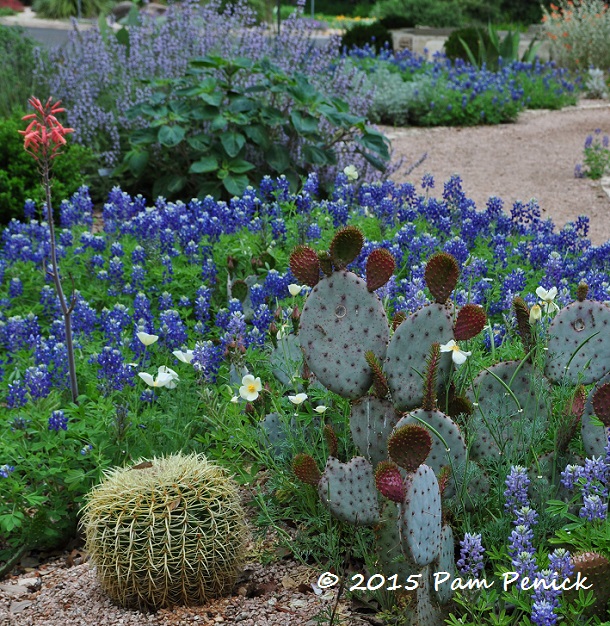
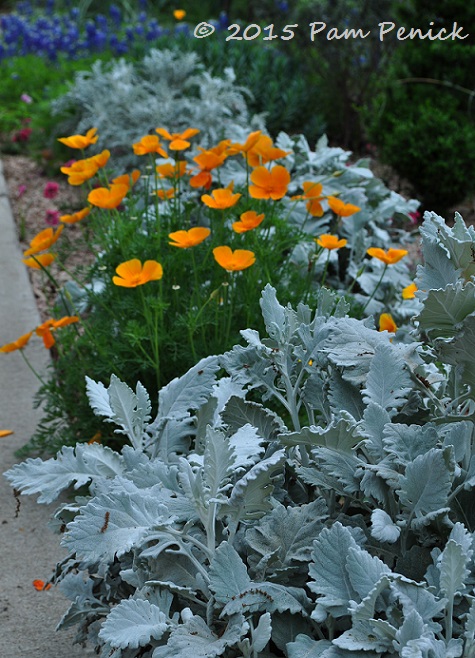
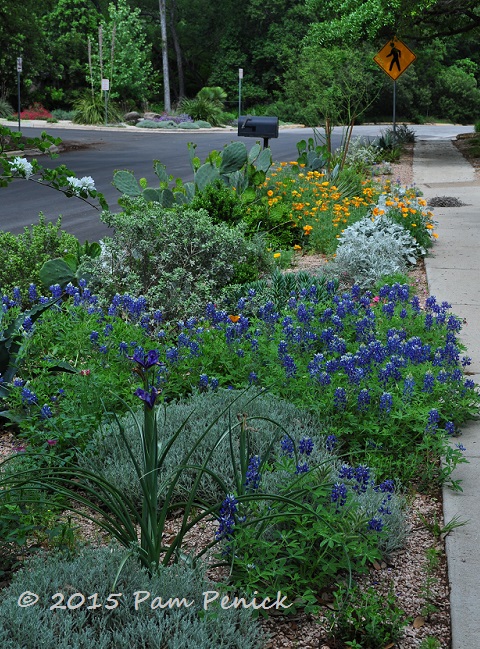
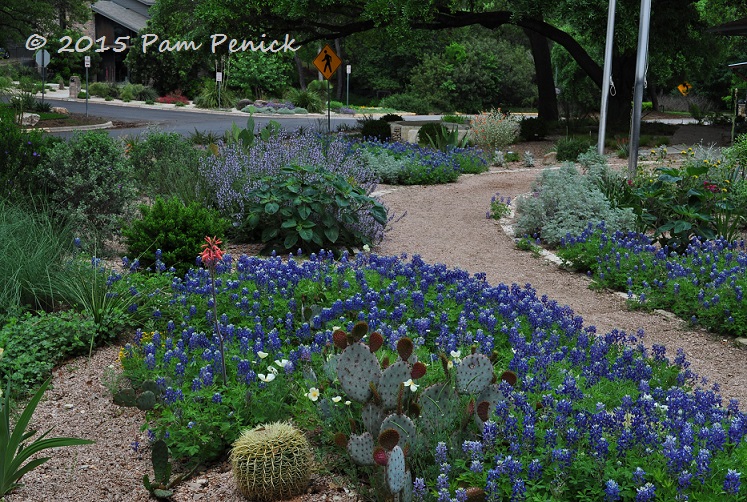
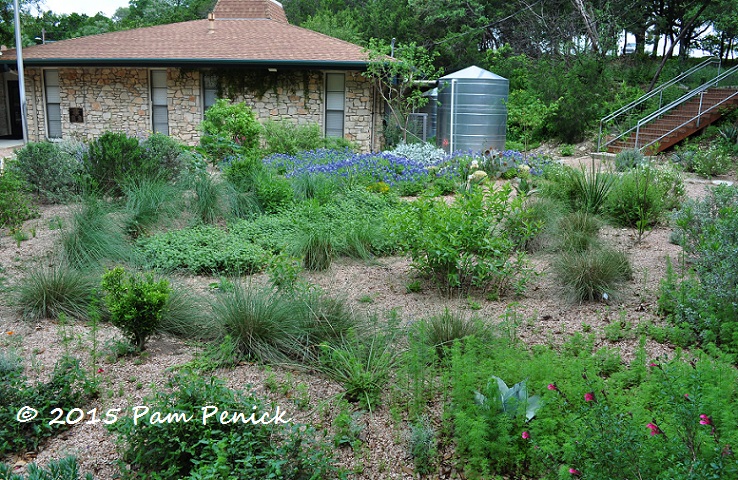
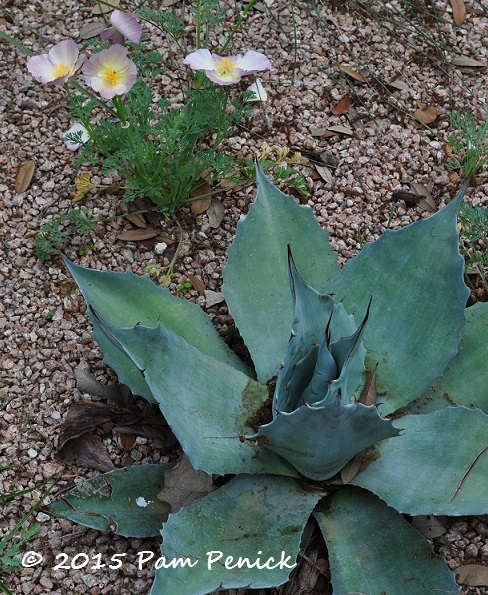
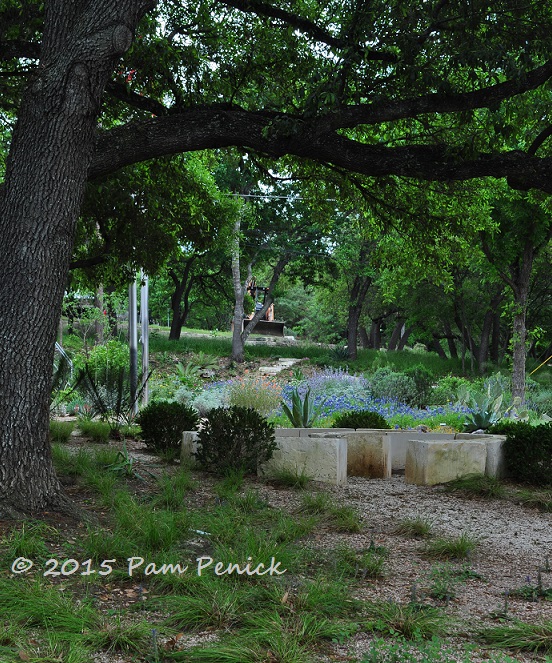
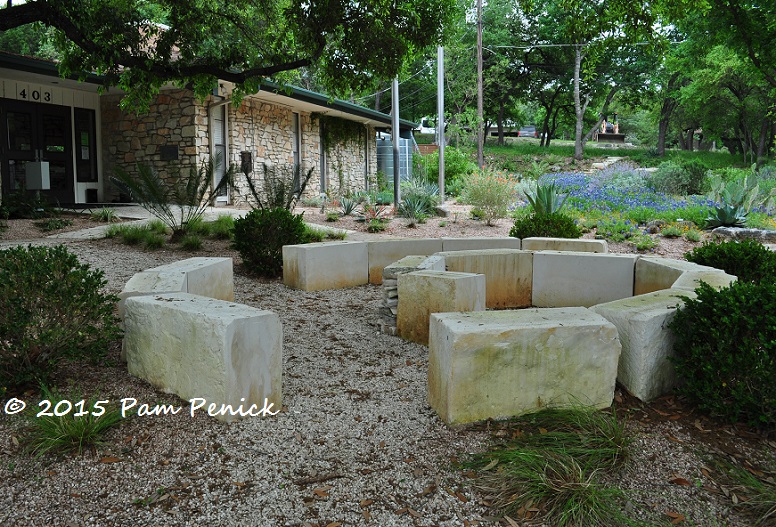
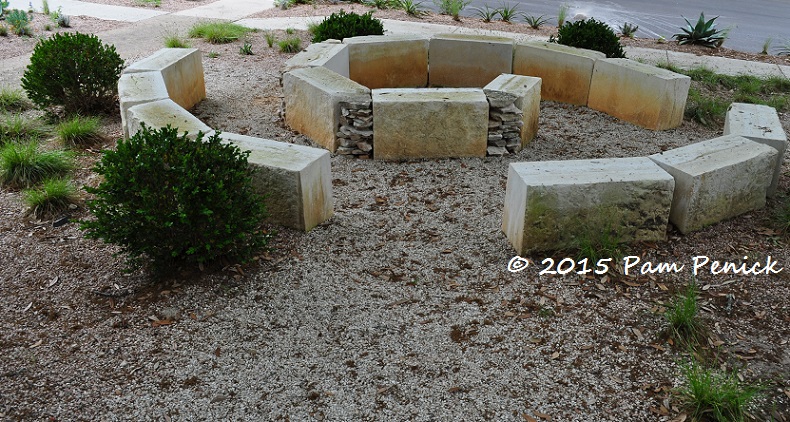
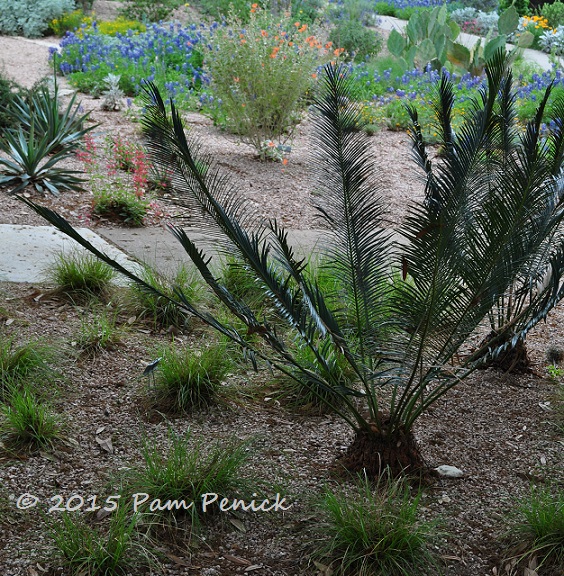
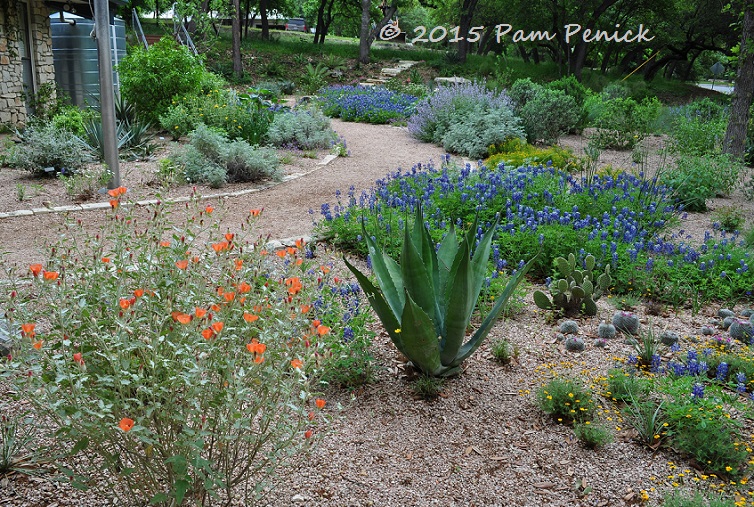
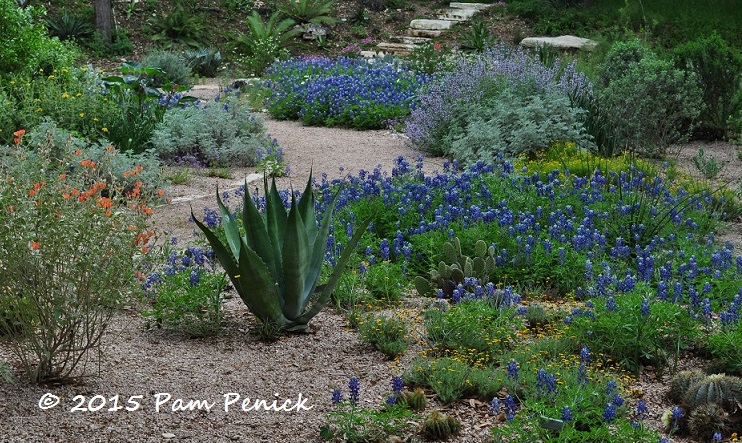
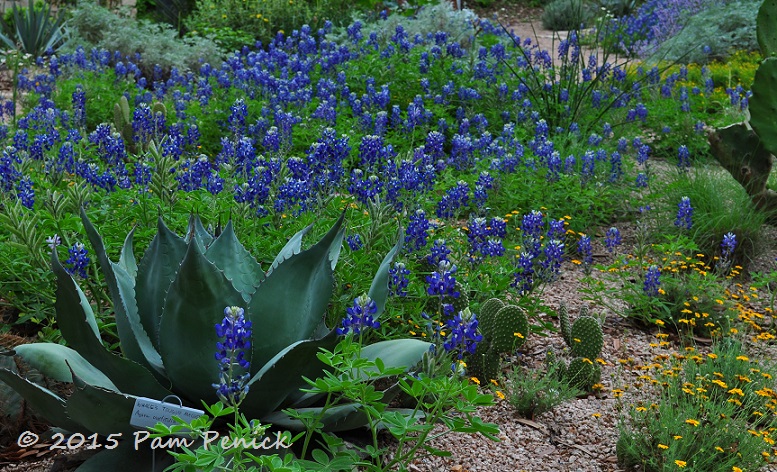
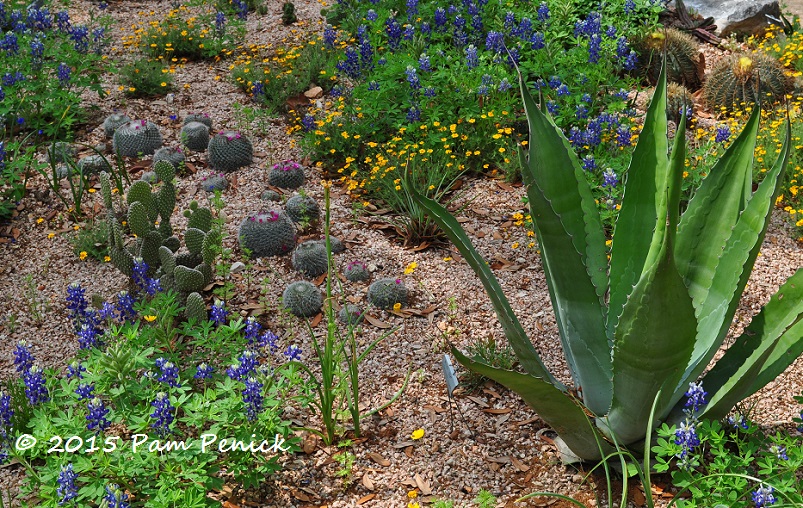
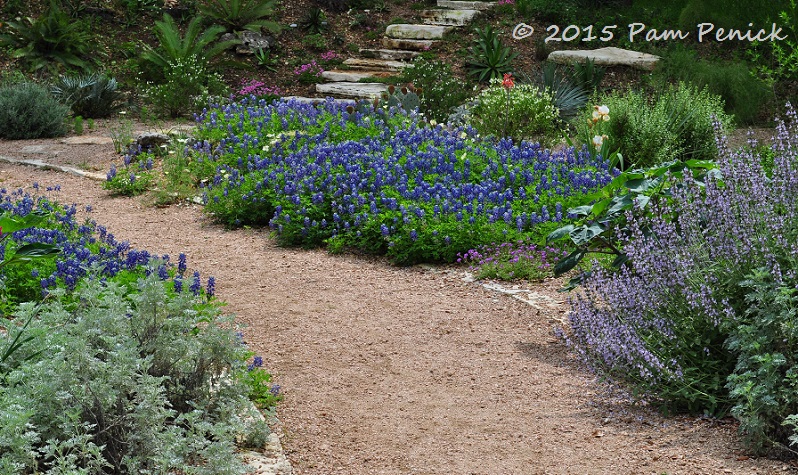
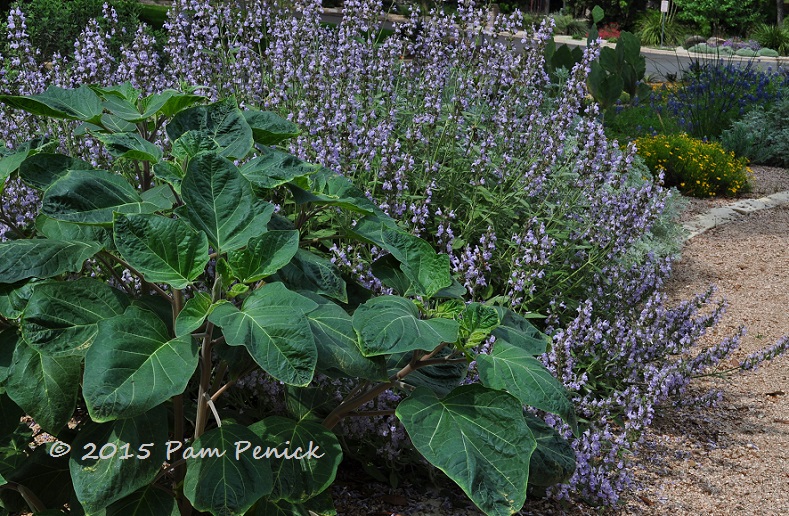
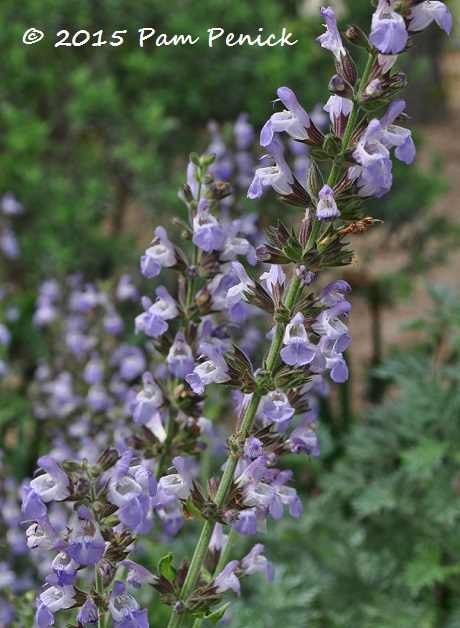
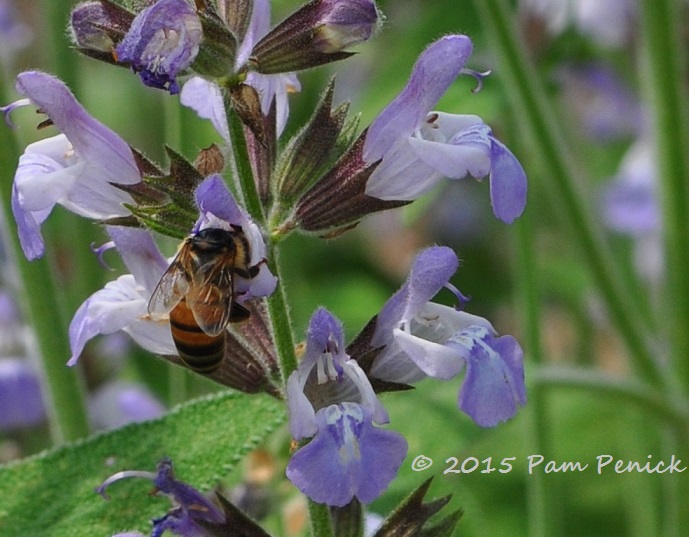
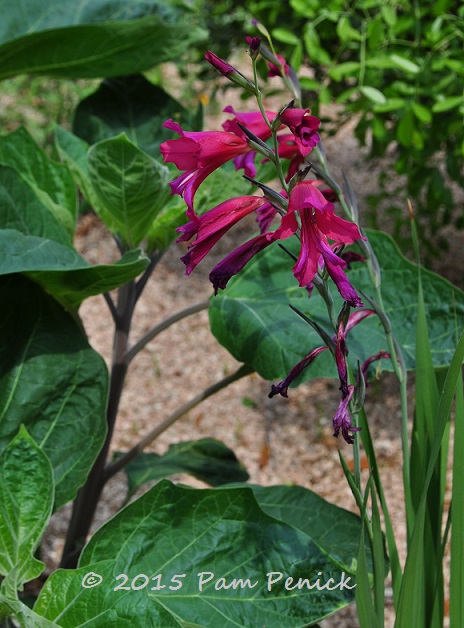
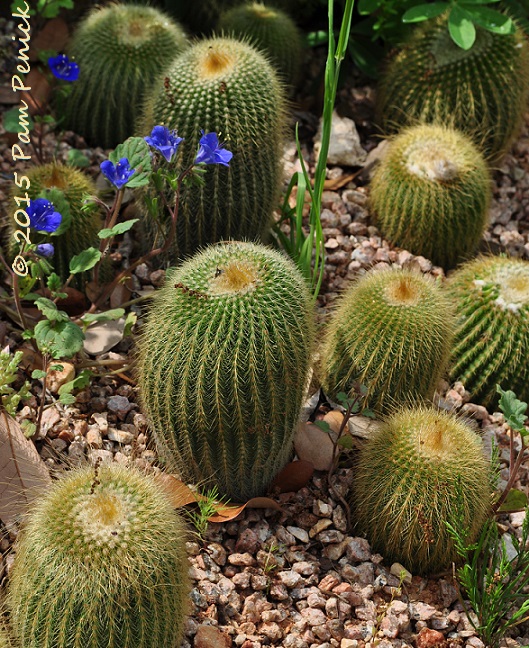
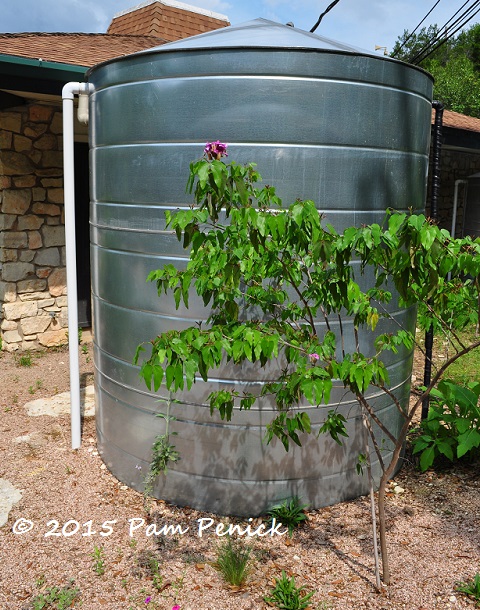
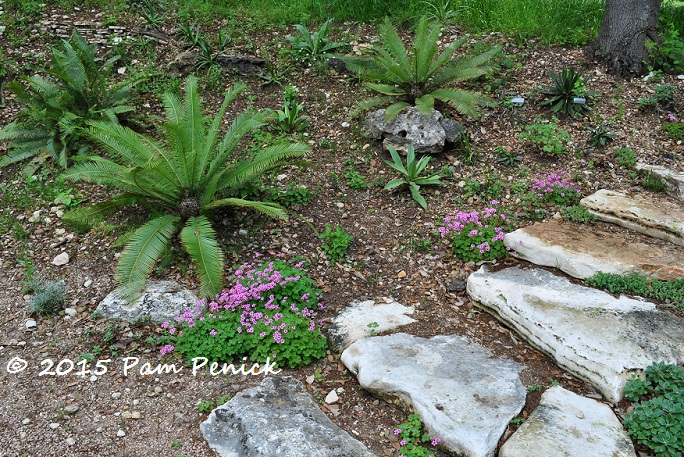
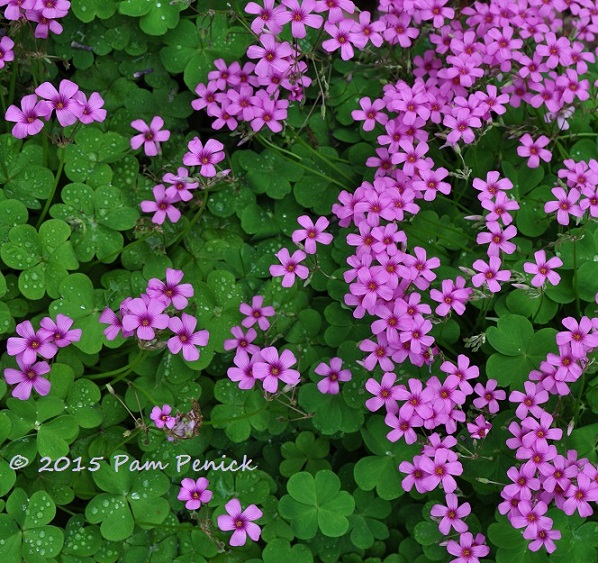
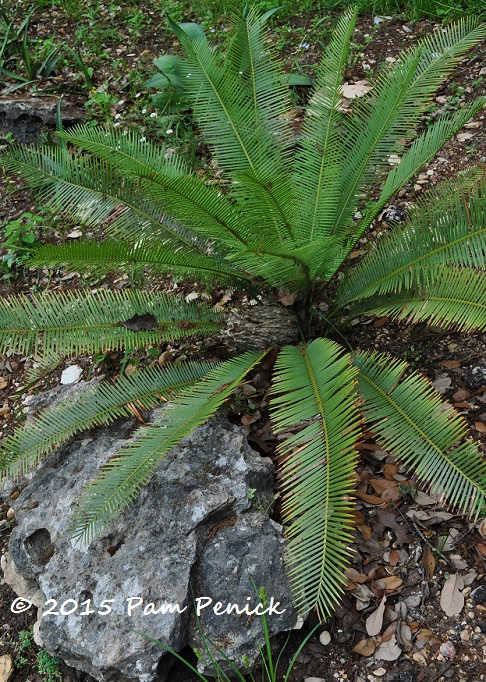
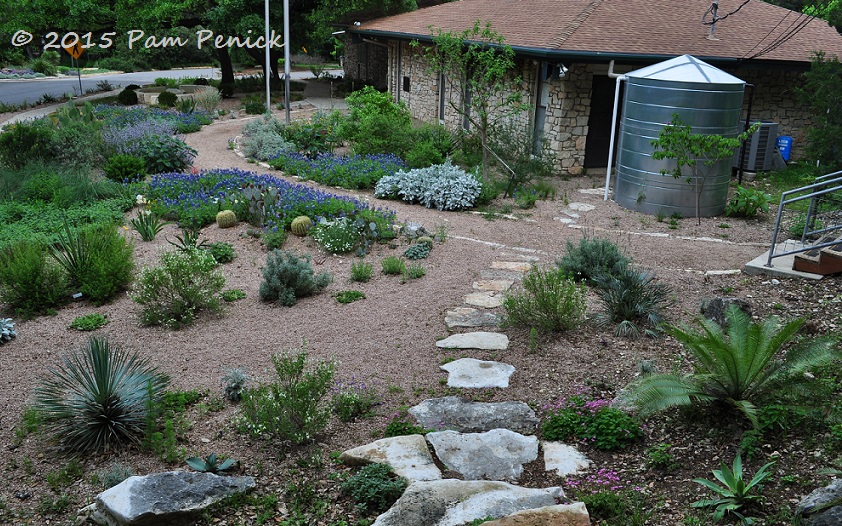
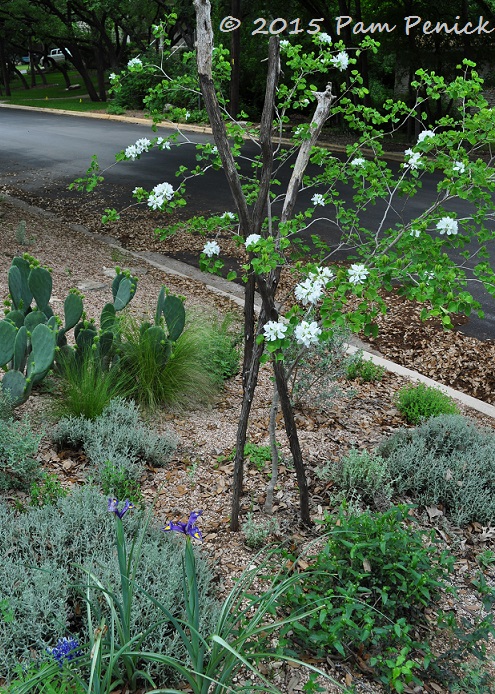
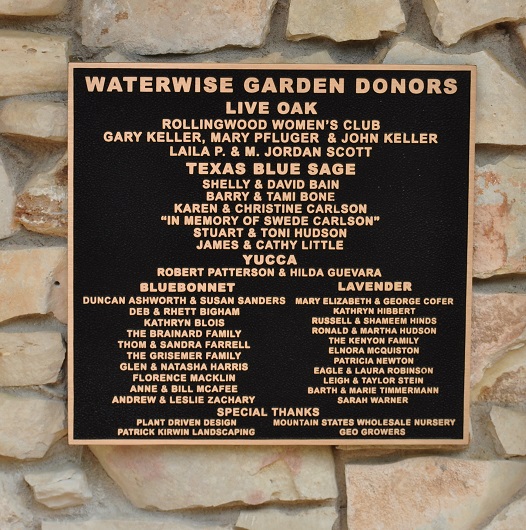
That is very creative and beautiful, and mostly necessary in these days. I wish more cities would try this. Gorgeous photos.
Yes, I do too, Kim. And this garden is still very new, so it’ll get even prettier as the plants fill in. —Pam
Pam….City Hall was built as such. The old city hall on different property is now a residence. We love our garden. Did you check out the permaculture and education vegetable garden in the back of the park?
I did not venture around back, Debra. Hope to see that area next time. Thanks for letting me know about the building. —Pam
I just love this garden with its casual arrangement of great plant choices. There’s so much to learn from your tour. Thinking about where I could put a spiral.
The blue salvia might be Salvia texana or Texas Blue Sage. Yep, I got the clue from the plaque, but I also had it in my garden for a while. Need to find it again.
The spiral is a cool idea, isn’t it? I’ll look into the Texas blue sage — thanks for the suggestion. The only pictures I can find online, on quick perusal, are close-ups, and I need a full plant photo to compare. —Pam
Via your blog I’m rapidly becoming a Texas bluebonnet fan.
And what a cool garden. Good use of color.
The bluebonnets are beloved indeed, not just in Texas but by wildflower lovers everywhere. I’m glad to help induct you into their ranks, Paula. 🙂 —Pam
Wow, this is pretty enough to be in any neighborhood. Well done!
They did a lovely job. And hiring the Ogdens played no small part in that! —Pam
Pretty and practical! I love the color scheme that they used, with all the blues and hints of oranges and yellows. And that spiral is very cool looking!
The spiral adds an artistic note, doesn’t it? I’ll have to revisit this garden in the fall to see how it’s grown. —Pam
Lovely, I can imagine how beautiful it will be in a few years. By the way, the ‘purple-flowering perennial’ looks like sage to me.
Yes, I agree, Caroline. Some sort of sage/salvia. —Pam
Inspiring garden. Where would I find a source for the angular gravel mulch?
I’m starting to be a real fan of your blog!
Any landscape supply yard will carry it, David. Just ask for local crushed gravel, and choose the size you want. 1/2-to-1 inch usually works well, although if you’re gardening on a slope without terraces, gravel will not hold during a heavy rain, so keep that in mind. —Pam
Yay! You came, you saw, you posted! It is a real treat to see the garden spaces through your eyes. I keep meaning to ask the nice folks who live across the street if they find it annoying or rewarding to have traffic constantly slowing as residents drive by. I know I still slow way down to enjoy the view and I go by there constantly!
I hope people won’t get the idea every xeric conversion has to cost thousands of dollars. This particular garden was planned, designed, and then installed all at once, including some major rain saving systems. People looking to replace lawn can choose to take things more gradually and spread expenses out over a longer period of time.
Could that salvia (and please recall how large a grain of salt you’ll need for any spontaneous ID information I provide) be culinary sage (salvia officinalis)? I know they have some in the gardens there. I’ve grown them for years to use in the kitchen and never seen a flower but this year something was just right and they are blooming all around town fit to beat the band.
Again, so happy you came! On behalf of the neighborhood, thank you!
Thank YOU, Deb, for letting me know about it. I plan to stop by again this fall to see it during our “second spring.”
I grow Salvia officinalis in my garden, and it’s much smaller in form while the leaves are broader, so I don’t think that’s it. But it’s some sort of salvia, I’m sure.
And you’re quite right to point out that xeric conversions don’t have to be pricey. Tearing out the lawn and replacing it with xeriscape beds, over time as the budget allows, is quite DIY-friendly, as I hope I showed in Lawn Gone! And even if you use a designer — which is a smart move, as far as I’m concerned — fees can be high or low depending on your design needs and who you hire. In Rollingwood’s case, their money went, I’m sure, to a nice design fee for two highly regarded, well known, experienced designers and a professional installation. The price seems fair to me for all the work that was done. —Pam
I agree. The money was (well) spent on respected professionals, who were given the chance to design and install a small showpiece. That was their charge, and that is what they delivered.
And phew! My personal record for wrong identifications remains intact. I sure hope you’ll post the ID when the mystery is solved? I have plans to hang around City Hall and hope somebody will ask ME what that plant is. (and I will know!)
Deb, Linda Lehmusvirta, who recently interviewed Scott Ogden about the garden, has ID’d the salvia as Salvia officinalis x S. fruticosa, aka Newe Ya’ar sage. So you were very close! —Pam
I think I’ll take a drive over there one day and stroll around. It will be interesting to see how it develops over time and as the plants fill in. I wonder who will take care of it as it certainly needs someone with native plant knowledge. That salvia does look like the culinary sage. I have one and it was blooming just like that. Maybe you have the Berggarten variety which has wider leaves and lower growing.
I tried the Berggarten, but it never did anything for me. The Salvia officinalis that I’m growing is ‘Purpurascens’ — and you’re right, there are several cultivars. I know your garden was decimated by the hail and isn’t blooming right now, Jenny, but do you happen to have a picture of your S. officinalis from before? I’d love to compare it with this one. As for maintenance, the Statesman article that I linked to said that the Ogdens are providing ongoing help with that. —Pam
Only just saw this request. Yes, I will root out a photo for you
So all of this probably had good composted soil brought in under most of these plants and then the gravel mulch on top?
Do we know if there is any kind of drip system that is connected to the cistern? I can’t imagine someone watering all of that by hand to get it established. It would be nice to know how it all was planted, (i.e. What comes up when the bluebonnets go to seed?) Do we know if Rollingwood is documenting the different seasons on a website? It is all quite lovely.
Pam, those are excellent questions, and I wish I knew the answers. I researched online while writing my post, but I wasn’t able to find detailed information on the City of Rollingwood website. The Statesman article, which I linked to, was the most useful thing I found. A website dedicated to the installation and upkeep of this garden would be really helpful.
On the upside, Central Texas Gardener recently filmed the garden, interviewing designer Scott Ogden in the process, and I believe that episode is scheduled to air this fall. I’m sure we’ll all learn a lot from it. —Pam
Great design! Perfect that there are beautiful and beloved natives (loving those bluebonnets with the orange California poppies) along with way cool well adapted plants! How refreshing that city hall is setting an example! Too often the water conservation sermon is preached from buildings with huge expanses of emerald green lawns that require more water than a small country! The seating spiral is way cool. Now, where could I fit that in my tiny garden? In places that have snakes, do they like to be inside rock structures like those cairns? Forgive my ignorance but we don’t have snakes here. Just thinking that it might be an interesting surprise to sit down on the blocks and have a snake or two slither out of the stacked rock.
I would say possibly, yes, Peter, not to mention scorpions and other creepy crawlies. For that reason I’d never have a gabion seating wall in my garden. People here don’t get all worked up about snakes though, and of course most are harmless. But really — no snakes where you live? I thought that was just Ireland! —Pam
Absolutely beautiful photos, Pam! I wish more cities would create waterwise gardens as well though we don’t have much of a problem with lack of water in PA, which my garden and I are very thankful for:)
Plenty of water is a blessing indeed — enjoy! —Pam
Thanks so much for such a super write-up and fabulous photos of our new baby in Rollingwood, Pam! It has just suffered some washouts with the crazy floods but all in all is doing very well. To answer some of your readers’ questions, yes Scott and I do the maintenance of the plantings but not of the non-living parts of the garden. The spiral seating is still not completed but should be by fall when the garden debuts as part of the Garden Conservancy’s Open Day in Austin in October. And no Scott and I were not paid much for this, local resident and activist and philanthropist Robert Patterson spearheaded this whole idea and approached us and we were thrilled by the opportunity to create such a unique public space in the Austin larger metro area that would serve as an example to residents, visitors, and municipalities alike, so we contracted to receive only $3000 for our design work, plant procuring, and plant placement. Kirwin Horticultural Services completed the install and created all the rock work, also at a discount of their normal fees. Public work is so fulfilling when we get great press like yours, Pam, and when the response is so positive, and equally importantly, when the powers that be are willing to invest in ongoing intelligent professional maintenance that is needed to keep a garden healthy, beautiful, and evolving. That is the last and most vital piece in public gardens, and so often ignored or played down in the United States while in Europe and the UK and Japan, the ongoing care of public garden spaces is of utmost importance and only the best pros in the field do it, not the lowest bidding landscaper with a mower and a blower in the back of his truck. Thank again so much for your awesome writeup and pics and let us know if you have any questions.
Lauren, I’m so glad you stopped by to share some behind-the-scenes info, which is helpful in understanding how these kinds of projects come together — usually thanks to a passionate, dedicated organizer and lots of generous people who believe in the project sharing their talents and skills. This garden is already inspiring people, and I know it will continue to do so. And I so agree with you about the importance of skilled and regular maintenance. It’s often overlooked, but it absolutely makes or breaks a garden. —Pam